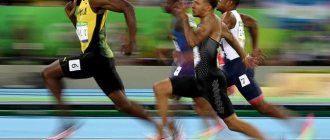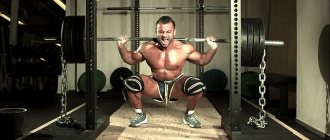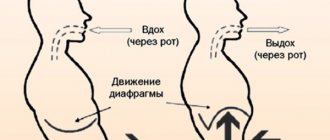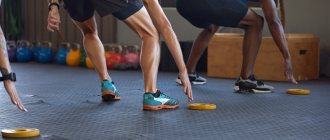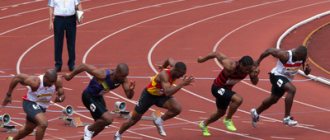Interval training
High intensity interval training is a great way to improve your speed and build confidence. Do speed reps once a week. For example, on a treadmill, you can run several 200-meter or 400-meter sprints with short intervals between sets. The workout is pretty simple.
- After a 5-10 minute warm-up, alternate between a vigorous 200- or 400-meter run and an easy jog or walk of the same distance to recover.
- If you have chosen a distance of 200 meters, then start training with 6 repetitions, gradually increasing their number to 8-10. For 400-meter intervals, perform 2-3 repetitions, increasing their number to 5-6 times. Training is equally effective when running on a track, stadium or treadmill.
If you are running along the road, lampposts can serve as a guide. For example, run intensely between three pillars and then simply walk to the next pillar. Use this pattern until you have covered one kilometer.
Sprint uphill
Beginners are always recommended to start with hill sprints as an introductory version of speed training. It builds leg strength, which can help prevent injury and improve running technique (due to the high knee lift during hill running).
Start with 5 10 second sprints at the end of your workout. Over the following weeks, gradually increase the number of sprints to 10, then decrease to 5, but increase the total time of hill running.
Increased stamina
If you want to increase your speed over one kilometer, you will have to run a much longer distance. Don’t force things and go long distances; gradually increase the distance while jogging.
- For example, now in one workout you run 2-3 kilometers, in a week you can cover about 10 kilometers, just add about 1 kilometer per week, until then you will not run 7-8 kilometers at a time. It turns out that you need to add only 10% to your weekly distance, gradually increasing the load and increasing endurance. This rate of increase in distance is also relevant when preparing for a marathon or half marathon.
Doing one long run per week will improve your cardiovascular fitness and strength, leading to faster running. You will also become more confident psychologically, and you will not feel discomfort in the last meters of the distance.
Calculating your running speed (pace and speed)
Preparing to cover a distance in a certain time involves properly controlling the pace of movement in order to achieve the desired result. He considers it best to cover the distance evenly. To do this, you should divide the entire distance into separate equal sections and imagine at what speed you need to overcome the next segment, that is, make a layout based on pace.
Running a half marathon distance requires divisions of 1 km and every 5 km. If you plan to complete a half marathon in an hour and a half, then the time for a kilometer is 4 minutes 30 seconds, and for 5 km - 21 minutes and 40 seconds.
Another important component is speed. Here you need to take into account the length of the distance and conduct training with a reserve of time and speed. The principle is quite simple, but it makes no sense to constantly calculate the necessary indicators. To do this, you can create a special table containing all the data for the main distances or use a pace and speed calculator. Such calculators are available in a large number of versions on the Internet. It is enough to enter the necessary data to get the required calculations.
Pace and speed calculation table
Table for calculating pace and speed for different distances, including half marathon and marathon
During training, many athletes use a wrist stopwatch with a heart rate monitor, which helps calculate the load, pace and speed for a given distance.
Increased stride speed
The speed at which your feet touch the ground is called stride speed or stride revolution. You should try taking faster and shorter steps, this will definitely increase your speed.
Most new runners have a running speed that is too slow. Trainers sometimes recommend taking 180 steps per minute. But still, some scientists believe that the speed of steps is a purely individual indicator.
You can determine your current speed and improve it with the following exercises:
- Determine your current performance. While running, count how many times your right foot touches the ground in 1 minute;
- Double this number to get your turnover rate;
- Try to improve it with a running exercise.
Run in 1-minute intervals, starting at your usual pace. Then run again, but increase the count of kicks. Repeat the sequence several times, each time trying to increase the number of kicks by one.
If you have a heart rate monitor, you can monitor your pulse. You perform your most effective steps at your lowest heart rate.
Follow the correct running technique. Your feet should be placed under your hips, not in front of your body, when running.
Speed football technique. (practice)
First of all, I want to draw the attention of readers that what is written below can be seen on my video channel on the Internet:
https://www.youtube.com/channel/UCuKMUX0I3donfU8kp8ysXQw?feature=mhee
Here I want to dwell on some key aspects of a football player’s high-speed movements, without which one cannot become a good football player in modern football. And the first thing I would like to start with is the running technique of a football player. The main disadvantage of slow-running football players is the short stride that he learned as a child.
Due to the fact that in childhood there is not enough leg strength for a long step, children get used to running in shorter steps than necessary. But then, when the football player has already grown up, he automatically runs, just as he ran in children’s football.
How to increase step length, a lot of specialized literature has been written and detailed descriptions of various exercises have been given that allow you to increase the length of your running stride. But here you need to pay attention that from the whole variety of training exercises aimed at increasing step length, you need to choose only jumping exercises in motion.
Advice!
No weights, squats with a load and jumping in the lower seat. Yes, if you do this, the strength of your legs will increase, your stride will lengthen, but your step frequency will drop and your running speed will not increase.
The main obstacle to increasing running speed is too much tension in the whole body, and the above exercises help strengthen the torso while running. A football player's running should be easy, but at the same time fast, and this is achieved by looseness (not to be confused with relaxation) of the torso while running.
I can give simple advice on how to increase the speed of movement around the field. While running, focus your attention on your torso and arms. Get them completely relaxed, and you will see for yourself how easy it will be for you to run and quickly change direction at speed.
An indispensable quality that determines a high-class football player is high start speed. Again, it is determined by the length of the starting steps. (Even commentators admire these long starting steps of high-quality football players). Increasing the length of starting steps is not difficult.
After the football player has learned not to strain his torso while running, he can move on to increasing the starting speed. To do this, you need to concentrate your attention on your legs, namely on the length of your step, while also not straining your torso too much. Believe me, the main thing here is not to strain your whole body.
Concentrate completely on your legs and everything will work out naturally. You need to ensure that the body seems to take off on its own. Once this has become successful, achieve a sharp change in direction immediately after the start and then train sharp accelerations with a change of direction while running.
Please note, I have not given a single exercise here to develop the running speed of a football player, but only explained what and how to correctly concentrate your attention during the run and start. This is exactly what I taught in practice to young and even established football players and other athletes.
Everyone, without exception, had the same result - an increase in running speed and, moreover! - increasing speed endurance.
Attention!
Another important point that you need to pay close attention to when teaching the technique of a football player’s movements during the game. During all game movements of a football player, his center of gravity should always be above the front part of the supporting foot.
Due to the fact that modern football is high-speed football, where players often fight in contact with an opponent, the advantage of one player over another is determined by whose body is closer to the ball, and this is only twenty to thirty centimeters.
Therefore, in order for the opponent not to have an advantage, the football player must always be ready to move, and for this, the relative center of gravity (RCG) of his body must be above the front of the foot of the supporting leg.
If the GCT is located above the back of the foot, that is, above the heel, then in order to start moving, you will still have to transfer the GCT to the front of the foot. If you have any doubts, try to quickly start the movement while standing on your heels.
And since moving the center of gravity to the forefoot requires time, although not much, it is still enough for the opponent to gain an advantage. During training, in order to learn how to determine, or rather feel, where the GCT is located, it is worth performing a simple exercise.
Due to the fact that the GCT is located in the area of the fifth sacral vertebra, then closing your eyes, standing on two legs, move the pelvic region of your body, and you will easily notice that as soon as the pelvic region moves beyond the support, so does the whole body at once follows in the direction where the pelvic region has moved. Experienced football players know that where the pelvic region is, there is the weight of the whole body, and no matter how many fraudulent movements the opponent makes with all parts of the body, he will move only where his pelvic region moves and react only to its movement.
On the subject: Running mask, what is it for?
Source: https://sportkuryachij.blogspot.ru/2012/02/blog-post.html
Improving your running technique
- At the beginning of each workout, take a few minutes to practice proper running technique. You can use simple warm-up exercises that will work on different aspects of good running form. This will ensure that your movements are enhanced while you run.
- Try adding four to six exercises to your warm-up that will improve your running form.
- For example, changing your stride quickly and efficiently helps you run faster with less energy. The fast legs exercise helps train your legs to move faster. Just run in place as quickly as possible for 1-2 minutes. Also perform kicks (raising your heels behind you toward your butt) to improve hamstring engagement.
After warming up and while running, pay attention to your posture, arm movement and leg position, as all these nuances directly affect your speed. Poorly executed movements will only waste your energy and slow you down. Work on your technique at a slower speed and you will definitely speed up later.
Tempo "3-1-4"
This pace of exercise will lead to a powerful increase in the mass and strength of your muscles. They will be subjected to two severe stresses at once. An extended positive phase of movement consumes a huge amount of energy, and an even longer negative phase leads to the formation of numerous microcracks in muscle fibers.
I would like to immediately emphasize that this pace of exercise is used only by very experienced athletes and professionals in iron sports. However, even they use this technique for a maximum of 4 weeks, followed by a 6-week rest. At the same time, they also reduce the total number of exercises and the working weights in them.
The “3-1-4” tempo still places more emphasis on the growth of muscle mass rather than strength, so this tempo cannot be considered universal either. The main purpose of its use is a powerful tonic effect, which should move the stagnation of the main physiological systems from the “dead point”.
Running on uneven surfaces
Running uphill helps improve performance by increasing your lactate threshold and reducing your running time. You can run on uneven terrain or use a special mode on the treadmill. But, unfortunately, on a treadmill you will not be able to simulate running down a mountain, and this is a very important part of training.
- Before running on uneven terrain, jog for 10-15 minutes at an easy pace. Try to find a hill with a gradual slope that extends approximately 100-200 meters.
- Start your uphill run at 5K pace. You'll want to push yourself up the hill, but don't force the form, go gradually. At the top of the mountain, stop, take a short rest and jog down.
- The number of repetitions depends on your experience and level of training. Beginners should start with 1-2 repetitions, adding one additional repetition every week for 3-4 weeks. Experienced runners can start with 6 reps and add one each week, ending at 10 reps.
- After completing all the repetitions, you need to jog for 15 minutes at a slow pace.
Factors affecting running speed
Running speed is influenced by innate factors that cannot be changed radically. You can't escape genetics. Only regular training with good dedication and overcoming one’s own indicators can maximize the potential of an athlete. Physiologically, running speed depends on the processes occurring in the nervous tissues, which is reflected in the frequency of muscle contractions, the ability to quickly relax and the ability to accelerate. Here you can remember the white and red muscle fibers. White fibers are responsible for muscle relief, volume and speed-strength indicators. The source of fuel for white or fast fiber is carbohydrate. The main task of such fibers is powerful short-term contraction.
In addition to congenital factors, athletic performance can be influenced by:
- Physical and moral condition.
- Overwork, both physical and nervous.
- State of mind.
- Weather conditions and equipment.
The components of running speed are stride length and frequency. This is what you can pay attention to during training.
Climbing stairs
If you don't have access to the mountains, use the stairs. Use the same approach as in the mountains.
- Find a multi-flight staircase
- Climb the stairs in 30 seconds, then go down to recover
- Repeat 5 times
- Gradually work your way up to 10 repetitions.
As your fitness level increases, try to run more stairs.
Keep up the pace
The goal is to run each interval at the same speed, something that beginners often overlook. The target pace should be a 7-8 on the perceived exertion scale (1 to 10).
Start with short intervals, and once you can maintain the same pace in each of them, start increasing the distance or number of intervals.
Losing excess weight
Losing a few pounds can cut your running speed by 20 seconds. But with active training and preparation for competitions, it is quite difficult to lose weight, because the body needs energy and you should not severely limit your diet. We recommend that you use the following recommendations when preparing your diet:
- Eliminate empty calorie foods. Sugary sodas, candy, fried snacks, and sugar-laden baked goods contain calories that are not good sources of nutrition.
- Eat foods rich in nutrients: vegetables, fruits and berries
- Choose meals based on lean protein, whole grains and leafy greens.
Also watch your portion sizes. You can eat a large lunch after your workout, but never eat more calories than you burned. To create an individual nutrition schedule, consult a nutritionist who will take into account the number of calories burned while running.
How do football players train endurance?
New generators: everything from jokes to accurate counting
A professional gambler whose main source of income is betting on sporting events must have a unique set of knowledge to predict the desired outcome.
Such people read and learn from trusted sources all the necessary information that can help in identifying the winner of the match.
It is important to take into account the physical condition of the athletes, their state of affairs in their personal lives, relationships with teammates, medical indicators and other components that will help in constructing a holistic image of the player to calculate the highest probability of the result of the match.
One of the objects of observation of professional forecasters is a well-known physical training coach for players in football circles, Richard Hawkins.
The mentor was part of the structure of the English Premier League club West Bromwich Albion; over time, he changed his location to a more eminent club with the centuries-old traditions of Manchester United.
A specialist conducts research in a special scientific laboratory.
Purpose
Richard Hawkins' training program improves the aerobic base of a football player. The consequence of the exercise will be an increase in the player’s ability to carry out intense actions at speed for a long time.
Attention!
This skill presupposes the emergence of an advantage over the opponent during important periods of the match, when the physical condition of many players has lost its optimal condition.
The main goal of such work is to maintain a uniform running pace for the football player during intense acceleration.
Execution Features
The inclusion of an exercise in the training process depends on the understanding and attitude of the head coach towards the type of activity that does not involve the player working with the ball.
The main principle of such training is to compare the physical efforts of a football player with the tolerable muscle loads during a full match.
Eliminating the fatigue factor during a sporting confrontation allows the player to better control the ball and apply his technical skills.
There are many alternatives to this type of load that can provide a similar effect. Many football clubs use Richard Hawkins' training program as a full-fledged exercise, and also include it in the training process as intermediate physical activity.
To complete the tasks set by the program, you only need to mark the football field and a few cones or chips to mark additional boundaries. It is worth noting that an unlimited number of football players can participate in such an activity.
Description of the training process
The “15/15” program, the name given to this training by Richard Hawkins, involves football players physically working for 15 seconds, followed by a 15-second rest. The execution scheme is quite simple, therefore it is convenient and used by many clubs:
Important!
The players line up on the edge of the penalty area and, when the whistle blows, move towards the central markings of the football field.
On the subject: Tibia hurts when running
Having reached the center line, the players turn 360 degrees and continue working in the opposite direction to the edge of the penalty area.
Next comes a 15-second rest, which is often filled with a recovery run to the baseline and back.
Repeated run.
Exactly 10 runs are completed in 5 minutes.
However, much depends on the overall training plan, which can include repetitions of up to 4 races with a recovery interval of 2 minutes. To achieve this effect, coaches often use two-way play with the goal moved or keeping the ball in a tight square, which helps maintain an intense training tempo.
Execution options
Football clubs require a large number of players on the team who have different physical abilities, so Richard Hawkins periodically uses the method of dividing football players into groups and changing the distance to perform the exercise. The initial interpretation of the training undergoes the following changes:
Reducing rest time to 10 seconds.
Reducing the running process to 12 seconds.
Increasing the distance covered while maintaining an interval of 15 seconds.
The starting line of the race also remains the border of the penalty area. In this case, players are divided into three groups, which are determined by the physical characteristics of the players:
The first group must run to the center mark of the field and turn around, covering a distance of 72 meters in a time interval established for all participants.
The second group runs 3 meters further than the center line of the field, so the players must cope with a distance of 78 meters.
Physically able football players from the third group must turn 5 meters further than the central marking, so they run a length of 82 meters.
Special cones or chips can be used to delimit the football field and create visual references for players.
Source: https://alvin-almazov.ru/soccer/5459/
Increased Strength
Building muscle will increase your speed and bring other health benefits. You don't even have to go to the gym, just do the following exercises after your run:
- 10-15 push-ups
- 10 lunges forward and sideways
- 10 single leg squats on each leg
- 1 minute plank.
These basic exercises will help you strengthen the muscles that keep your body strong and stable.
Doing strength training after your running workout will help ensure you are fully rested on your recovery days.
Tempo "2-1-4"
It would be logical to assume that this pace is the shortest path to muscle growth. After all, the duration of the negative phase, which is responsible specifically for the growth of muscle volume and weight, has been increased. However, muscle work in the negative phase, even when performing the exercise very slowly, consumes a very small amount of energy. And therefore, the internal energy system does not receive extreme stress, which in turn does not trigger the body’s adaptive reactions. The source of energy - glycogen is not deposited in the liver and muscles; in this case, the body does not adapt to increased stress. Thus, the 2-1-4 tempo, if applied to all exercises, can easily cause overtraining.
Another fact is that the anabolic effect of the negative phase is very limited. In this mode of operation, muscle cells are actively destroyed. Protein molecules then travel to the sites of destruction and begin to restore the damaged areas. Muscle cells repair and become larger, which is how they grow.
However, an increase in strength indicators is observed only in the positive phase of the movement. The weight you lift at a 2-1-4 pace will remain virtually unchanged and you simply will not be able to increase it. Yes, muscle mass and volume will grow much faster, but this growth will soon stop, because the volume of a muscle is directly proportional to its strength! From here the conclusion is: the “2-1-4” technique will be effective only for a short time, after which it will be necessary to change the tempo to a more powerful one.
Tempo of weight training
For beginners, it is best to choose a slower pace of exercise - a couple of seconds to lift the weight, and then four to lower it. This way you will protect yourself from the risk of injury. In addition, it is useful to stretch out the repetition time. These figures, of course, are arbitrary, but still, it is worth adhering to the scheme, according to which 2 times more time is allocated for lowering the projectile. You can even track your first time using a stopwatch. Over time, your own internal account will appear - you will develop a subconscious habit. Additionally, a tempo of 6 seconds will help you feel the muscle work. If you don't learn this, it will be difficult to organize decent muscle stimulation training in the future.
Low speed of exercise
If the weight on the apparatus approaches one hundred percent of the athlete’s one-time maximum, then it is unlikely that it will be possible to quickly perform the movement.
And even with a relatively small load, it is best to deliberately reduce the speed of performing exercises in bodybuilding and fitness as much as possible. If you choose a slow pace, then the articular-ligamentous apparatus receives more load. In order to continue working with serious weights, it is necessary to strengthen it. In order to focus on working on the ligaments, it is best to carry out static pauses, literally a few seconds long.
A leisurely pace will help to saturate the muscles being developed to the maximum with blood during pumping training. The nutrients will influence further muscle growth.
High speed of exercise
Fast twitch muscle fibers provide explosive strength.
This result is possible with a fast pace of exercise in sports. Among the classics, it is worth highlighting weightlifting snatches. The same applies to the clean and jerk, athletics throwing disciplines and strikes. To conduct training at a fast pace, you should use weights that do not exceed 60 - 70% of the bodybuilder's one-time maximum. The speed of the projectile should increase throughout the entire amplitude of movement of the exercise - lift the projectile to the maximum upper point by the force of inertia.
Thanks to high-speed training, it becomes possible to quickly and impressively develop fast muscle fibers, which have maximum growth potential and explode the overall growth of muscle tissue in a bodybuilder.
High-tempo training is only appropriate for basic exercises for those who have already managed to strengthen their ligaments as much as possible.
Average speed of performing exercises in bodybuilding and fitness
This is the most popular type of training in bodybuilding.
During such training, it is possible to use a maximum of muscle fibers of all types - fast and slow, intermediate. This type of training involves an uneven speed of performing exercises during different phases when working with a projectile. The descent is a couple of times slower than the ascent. It is very important that the weight is controlled and not just thrown down. After all, in this way muscle work is reduced, which leads to the threat of injury.
Medium speed training is good for working with a wide range of weights ranging from zero to ninety percent of your maximum. Thus, it is possible to use this type of training in various training programs that are designed for a particular number of repetitions in a set.
Maximum, average and record running speed
A fast step is considered to be moving at a speed of 5–8 km/h. Running starts at 9 km/h. In theory, the maximum running speed of a trained person can reach 64 km/h, but so far no one has been able to come close to this figure . Usain Bolt's world record, listed in the Guinness Book of Records in 2009, is 19.28 km/h less than this figure.
In practice, a person’s running speed depends on the body’s endurance, weight, height, goal and, especially, the distance covered. Each running distance in athletics has its own name and best indicators:
- Sprint is short distance running from 100 to 400 meters. In the fastest form of running, athletes do not need to distribute their forces. In order to run quickly in extreme conditions with a lack of oxygen, they have to train using a special anaerobic technique with holding their breath for a certain segment of the distance. The best sprinters run 100 meters in 10–11 seconds. The world record is held by Jamaican athlete Usain Bolt, who ran the 100 meters in 9.58 seconds and the 200 meters in 19.19 seconds. The 400-meter record holder is Weide van Niekerk with a result of 43.03 seconds. However, endurance champions demonstrate such indicators in competitions, and during regular training they run 10–30% slower.
- Stayer - average distances ranging from 800–3,000 meters. Stayer running is not much different from marathon running. Athletes have to use different running techniques: run smoothly for most of the distance, saving strength for acceleration at the finish line. The average speed of an adult with training experience is 18–23 km/h.
- Marathon - long distances of more than five kilometers. Over long distances, athletes reach their maximum possible speed in the last section. But because marathon runners have to distribute energy over long distances, they cannot accelerate like sprinters. Beginners complete marathons at an average speed of 9–12 km/h, while trained athletes run 16–18 km in an hour. Wilson Kipsang showed the fastest speed at a distance of 42.2 km. He accelerated so much in the last seven kilometers that the average was 20.5 km/h.
The sporting achievements of the fair sex are 8–14% less than those of men. My running results are worse for several reasons:
- increased muscle elasticity;
- the proportion of adipose tissue is approximately 10% higher compared to men;
- the proportion of muscle mass is 15–25% lower;
- the volume of the lungs and heart is 10–15% less;
- hemoglobin is 15% lower than in men, which causes the body’s lower ability to transport oxygen;
- 20% less energy-generating mitochondria;
- the level of testosterone, which regulates the functioning of the musculoskeletal and endocrine systems, is 10–15 times lower than in men.
How to increase endurance for playing football?
Even if you attend a football school or football section, additional classes will not be superfluous, because with their help you can speed up your process by an order of magnitude.
In addition to handling the ball and being able to hit it hard and accurately, you need to improve your running speed and increase your endurance. In general, there are two key types of endurance in running, namely: speed and general. The first is needed in football in order to make as many high-speed bursts as possible during the game.
As for the second, it is needed for the purpose of playing the entire match to the maximum of your capabilities.
It should be said that you can purchase high-quality covering for running tracks at one of the lowest prices at Olympic Field LLC. The company's products are represented by coatings intended for the floors of outdoor and indoor sports fields, stadiums, as well as garages and homes.
